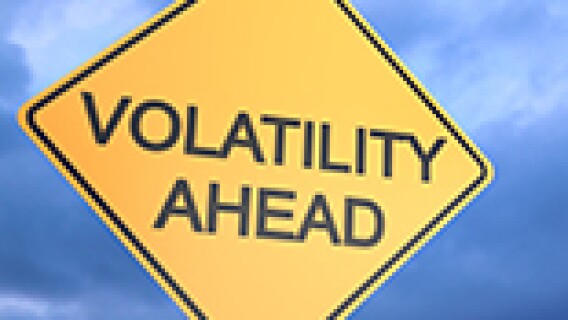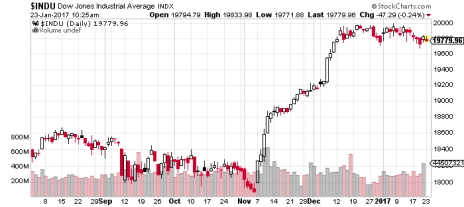The night Donald Trump was elected, it appeared investors were in for one of the most extreme periods of market volatility since the recession. Dow futures plummeted more than 800 points as it became increasingly clear that Trump was going to defy all pre-election polls and become our 45th President.
Fast forward two and a half months, and volatility is at its lowest point in decades—even now that Trump has been sworn into office. Since spiking to 22 the week before the election, the Volatility S&P 500 (VIX)—a measure of market volatility, a.k.a. the investor “fear gauge”—has been consistently in the 11-to-14 range, and is just off a 52-week low. And as our growth expert Mike Cintolo wrote last Friday, the S&P 500 has been stuck in a narrow 2.1% trading range since December 8.
[text_ad use_post='129629']
During that same six-week stretch, the Dow Jones Industrial has been confined to an even tighter trading range, with a high of 19,974 and a low of 19,732 (see chart below). That 1.2% trading range is the narrowest in exactly 60 years, since 1957. The previous one-month volatility low for the Dow (and mind you, this narrow range has lasted two weeks longer than that!) was 1.85% in August 2005. In a typical month, the average trading range is between 6% and 7%.
In other words, since the major run-up in the month that followed Trump’s surprise election, market volatility has been at almost unprecedented lows. At some point, investors collectively hit the pause button on all the post-election fervor, and have yet to hit start in the six weeks since.
Eventually, stocks will break out—probably in a very big way. Who knows what the trigger will be—a new Trump policy (or Tweet), a round of earnings beats or misses, the next bit of economic data. Regardless, you should be prepared for a major market move in either direction, and poised to either protect your portfolio accordingly, or possibly (hopefully) add to it.
Stocks traded in a pretty tight range prior to the election, and you can see from the chart how big the breakout to the high side was after the election. I won’t try and predict when the next breakout might come, and certainly not which direction stocks will break when it does. But there’s a reason we haven’t seen a trading range this narrow in 60 years. Stocks can only stay in a holding pattern for so long. At some point, the ongoing stalemate between the bulls and the bears will end, and one side will swoop in and make a move.
When it happens, stock market volatility could return in a big way. Prepare accordingly.

Sign up now!

Sign up now!

Sign up now!

Sign up now!


